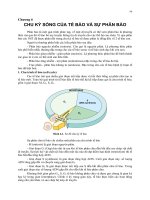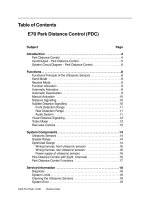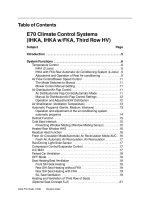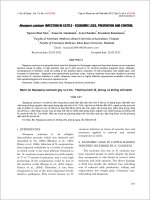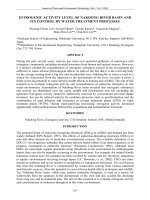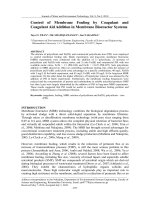C6 sand control WHY??????????
Bạn đang xem bản rút gọn của tài liệu. Xem và tải ngay bản đầy đủ của tài liệu tại đây (1.27 MB, 35 trang )
Designed & Presented by
Mr. ĐỖ QUANG KHÁNH, HCMUT
03/2014
Đỗ Quang Khánh – HoChiMinh City University of Technology
Email: or
1
Content & Agenda
Introduction
Causes and consequences of sand production
Sand Production Prediction
Sand control methods
Ref:
Reservoir Stimulation, 3e – Economides & Nolte
Petroleum Production Systems - Economides et al., 1994
Production Operations: Well Completions, Workover, and Stimulation -Thomas O. Allen,
Alan P. Roberts,1984
Introduction
o Why Sand Control?
The production of formation sand with oil and/or gas creates a number of potentially
dangerous and costly problems
Losses in production can occur as the result of sand partially filling up inside the wellbore.
Creation of void and breakouts behind the casing, shale streaks remain unsupported and
creation a formation damage in the near wellbore region
Sand & particles transported with fluids cause severe erosion damages, especially in gas wells
If the flow velocities of the well cannot transport the produced sand to the surface, this
accumulation of sand may shut off production entirely.
If shutoff occurs, the well must be circulated, or the sand in the casing must be bailed out
before production can resume
Once produced sand is at the surface and no longer threatens to erode pipe or reduce
productivity, the problem of disposal remains. Sand disposal can be extremely costly,
particularly on offshore locations
Introduction
When is Sand Control Required?
CAUSES OF SAND PRODUCTION
1.
Sand grain slippage, collapse of the perforation tunnel, wellbore or cavity, resulting from:
2.
A significant pressure gradient across the sandface. This can result from:
3.
high drawdowns;
pressure depletion;
wellbore deviation;
pressure surges during rod pumping.
high fluid viscosities (>50 cp,), especially in heavy oil wells where viscosities may exceed 1000 cp;
turbulence in the pore throats in gas wells and high-rate or high gas-liquid ratio (GLR) oil wells;
formation damage and plugging of perforations and pore throat areas.
Increasing water saturation and water cuts, which destabilize the sand as a result of:
reduction in the cohesive strength and inter-granular friction
mobilization of the fines from around the grain-to-grain contacts
chemical reaction with the natural cementing materials, especially if salinity changes occur with water
breakthrough
operators increasing the gross production rate and draw-down to compensate for decreasing relative
permeability to oil and oil production volumes
increasing drag forces on the grains due to movement of the wetting phase (i.e., the connate water)
Initiation OF SAND PRODUCTION
Sand production is initiated when the forces acting to dislodge sand grains from the formation
exceed the strength of the rock
Dislodging forces included mechanical stresses in the rock and the drag forces associated
with fluid flow
Pore pressure relieves frictional forces
Production of wetting phase reduces capillary pressure forces
Resisting forces include rock strength parameters and capillary pressure forces
Intergranular frictional forces and bonding (cementation) help resist grain movement
Capillary Pressure adds further grain-to-grain bonding
Initiation OF SAND PRODUCTION
Sand production is initiated when the forces acting to dislodge sand grains from the formation
exceed the strength of the rock
Dislodging forces included mechanical stresses in the rock and the drag forces associated
with fluid flow
Pore pressure relieves frictional forces
Production of wetting phase reduces capillary pressure forces
Resisting forces include rock strength parameters and capillary pressure forces
Intergranular frictional forces and bonding (cementation) help resist grain movement
Capillary Pressure adds further grain-to-grain bonding
•
•
•
•
Sand Production May Begin Late in the Life of a Well
Pressure pulses caused by non-steady production
Increasing mechanical stresses caused by pore pressure reduction
Increased drawdown leads to increased drag forces
Water breakthrough can severely reduce capillary pressure forces
Effects OF SAND PRODUCTION
Accumulation in surface equipment
– Increased maintenance costs
– Costs associated with deferred production
Accumulation downhole
– Frequent clean-out trips
– Decreased productivity
Erosion of downhole and surface equipment
– Frequent workovers
Formation collapse and casing damage
– Loss of well
Prediction OF SAND PRODUCTION
•
•
•
Sand Production Prediction
Determine which wells have the potential for sand production
Determine best time to institute sand control methods
Assess economic impact (both positive and negative) of incorporating sand control
Probability of Successful Sand Production Prediction
•
•
•
•
•
Typically good prediction in “definitely will” or “definitely will not” fail categories
Majority of the wells and reservoirs fall in between these two extremes
Marginal formations difficult to accurately predict
Multi-phase fluid flow is a complicating factor
Effects of changing production character difficult to predict
Sand Prediction and Sand Control
•
Most authorities recommend that sand control techniques be applied immediately upon indication that a formation
will produce sand.
This practice will allow the highest success rate and the lowest production loss possible after sand control is
applied
Laboratory studies have shown that once an unconsolidated sand is disturbed, the sand cannot be packed back to
its original permeability.
Sand control should be applied before the reservoir rock is seriously disturbed by sand production.
•
•
•
The factors tending to prevent sand production
1.
The amount, strength, and nature of the rock cementation.
2.
The shape and arrangement of the sand grains, which will determine the inter-
granular friction.
3.
The degree of compaction, which is generally proportional to the overburden
loading (or depth) and inversely proportional to the initial reservoir pressure.
4.
The behavior of the rock after initial failure in terms of:
plastic deformation of the cavity wall;
natural arching of the unconsolidated or failed sand around the perforation tunnel.
Sand Failure
Parameters
Porosity
Permeability
Geological Age
Formation Depth
Depositional Environment
Fluid type
Primary cementation
Values
>20%
High
Miocene to present
<8,000 ft
Dirty
High water saturation
Poor
Rate Control and Arching Effects
A consideration of the mechanisms of sand failure should
make it apparent that reducing the rate and drawdown should
reduce sand influx
Rate control is therefore only a temporary sand control method
Selective Perforation
Identify the potential sand-producing zones from log
measurements.
As a rough rule of thumb, many completion engineers often
use a sonic log threshold of 100 µs/ft (325 µs/m) for
identifying potential sand-producing intervals.
FORMATION SAND ANALYSIS
Formation Sand Characterisation
Sand sampling is critical to any type of sand control technique
Representative of the entire interval under consideration
Analysis to be performed:
– Sieve Analysis (most used)
– Laser Light Scattering (grain size underestimation)
– Clay Content
– Acid Solubility
– Fluid Compatibility
– Porosity and Permeability
– Wettability
Types of formation sand samples: Drill cuttings, Produced samples, Bailed samples, Sidewall core samples,
Conventional core samples
Sample size and frequency
– Minimum sample size is 15 cubic centimeters
– Samples required every 2 to 3 feet or at every lithology change
Sieve Analysis
•
•
•
Sieve Analysis Apparatus
Laboratory technique to determine grain size and size distribution of a sand sample
Consists of a series of wire mesh sieves with progressively smaller openings
Sieves are stacked and shaken or vibrated to separate sand grains according to size
•
•
•
Sieve Analysis
Sand sample must be cleaned to remove all mud, fines (clays) and cementation material
Sand sample must be broken down to individual grains for accurate results
Samples must be sieved long enough to allow complete separation of various grain sizes
U.S. Mesh
•
•
•
U.S. Mesh Definition of Grain Size
Mesh refers to the number of openings per linear inch
The width of the opening depends on the mesh and diameter of the wire
The U.S. Mesh series specifies the mesh size and width of opening
Sieve Analysis Sizes
U.S. Mesh
•
•
Sieve Analysis Procedure
Sieves are weighed before and after sieving to determine weight of sample retained by each sieve
size
Grain size versus cumulative weight percent can be plotted on semi-log coordinates to obtain grain
size distribution
Grain Size Distribution Plot & Sand Classification
Sieve Analysis Indicates Uni. & Non-Uniform
Formations
Uniformity Coefficient
Ex:
SAND CONTROL TECHNIQUES
Sand Control Techniques
Passive approaches
– Maintenance and workover
– Rate exclusion
– Selective completion practices
Active approaches
– Plastic chemical consolidation
– Resin coated gravel
– Slotted liners or stand alone screens (without gravel packing)
– Expandable screens
– Gravel packing
Maintenance and Workover
Maintenance and Workover
Requires bailing, washing and cleaning of surface facilities to remove formation sand
Used when:
– Sand production is limited
– Production rates are low
– Well intervention risk is low
– Cost of more proactive sand control technique is not economically justified
Rate Exclusion or Production Restriction
Rate Exclusion or Production Restriction
Reduction in prod. rate will reduce drag forces and drawdown to provide reduced risk of sand production
Procedure:
– Slowly increase rate until sand production begins to increase (Critical Drawdown)
– Sequentially reduce flow rate until the sand production declines to an acceptable level
Attempting to establish maximum flow rate in conjunction with stable arch
Horizontal Wells???
Limitations
The reduced production rate that excludes formation production sand is not profitable.
Production rate is not always the only factor contributing to sand production.
The degree of consolidation of the formation, the type and amount of cementitious material present, and
the amount of water being produced are also significant contributing factors to sand production.
These other factors may allow a well to produce sand even after the production rate has been severely
restricted
Selective Completion Practices
Selective Completion Practices
Perforate or complete only high strength layers
Perforate at high shot density
Need good hydraulic communication
Poor sweep efficiency
Risk to leave reserves unrecovered
Plastic Consolidation
Plastic Consolidation
Goal is to inject plastic resins into the formation to provide increased compressive strength while
maintaining acceptable permeability
Treatment objective are:
– Cover entire perforated interval
– Coat all sand grains with resin
– Concentrate resin at contact points
– Leave pore spaces open
Three types of resins systems available:
– Epoxies
– Furans (and furan/phenolic blends)
– Phenolics
Plastic Consolidation
Plastic Consolidation Placement Technique
Verify rock wettability
Pump a preflush treatment to restore water wettability
Pump the treatment inside the formation
Wait for rock grains coating
Flush back the excess treatment fluids
Pros and Cons of Plastic Consolidation Treatments
Plastic Consolidation
Resin Coated Gravel
Resin coated gravel or gravel mixed in a resin carrier fluid is pumped to fill voids behind casing and
perforation tunnels
Resin is allowed to consolidate
Casing is drilled out to leave wellbore unobstructed
Resin Coated Gravel Limitations
Must have complete coverage of perforated interval to be successful
Good compressive strength of resin coated gravel requires high temperature (>300ºF)
May reduce near-wellbore permeability
Long term reliability
Resin Coated Gravel Screenless Frac-Pack
Similar to resin coated gravel treatment, but gravel placed above fracture pressure
Gravel is underflushed at end of fracture job and allowed to cure
Casing is drilled out to leave wellbore unobstructed
